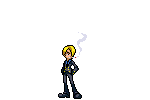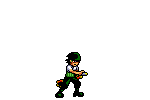
Kenshin is born into a peasant family under the given name of "Shinta". After losing both his parents to cholera by age seven, he is later sold into slavery. The slave-traders' caravan is then attacked by bandits who killed all with the exception of Shinta, who is saved by Seijūrō. Seijūrō decides to adopt Shinta into his apprenticeship, and renames the boy "Kenshin" (with 'Ken' meaning 'sword' and 'Shin' meaning 'heart'), believing that 'Shinta' is not a fitting name for a swordsman.
After a few years under Seijūrō's guidance, Kenshin's wish to protect the people with his skills results in his abandonment of both his master and his training. His sword skills soon attract the attention of Takasugi Shinsaku, who transfers him into the ranks of Katsura Kogoro, a leader of the Chōshū clan. Kenshin is sent to Kyoto and assigned the role of an assassin, sharing the common goal of the Ishin Shishi upon the Tokugawa Shogunate. Within the first six months of his career, he kills over 100 people, and eventually became known as the "Hitokiri Battōsai". At one point, he comes face to face with Yukishiro Tomoe, who initially wanted to avenge the death of her fiancé, whom Kenshin had killed, but falls in love with him instead. After the crisis suffered by the Chōshū clan in the Ikedaya Jiken, both Kenshin and Tomoe get married and flee to a remote village.

Kenshin's desire is to protect people from danger without killing. Formerly known as "the strongest hitokiri," Kenshin is the main target of many old enemies, thus he avoids letting others get too close to him personally for their own protection. However, he eventually begins relying on a few friends, such as Sagara Sanosuke, his most reliable friend, and Myōjin Yahiko, whom he sometimes allows to fight alongside him. He also has a rivalry with the ex-Shinsengumi member Saitō Hajime since the Bakumatsu. Although they become partners in the series, they both know that one day they will finish their duel. After the end of the Jinchu Arc, Kenshin challenges Saitō to end the rivalry but Saitō refuses to fight since Kenshin is different from the time they were enemies.
Throughout the series, a young woman named Kaoru develops strong romantic feelings for him, and he also comes to love her. Despite his feelings, he is constantly haunted by the wrongs committed in his past, and believes he does not deserve happiness. However, as he notes how Kaoru would feel if he dies, Kenshin decides not to leave her and regains a desire to survive.
If he is not able to protect his loved ones, he begins to shift into his "Hitokiri Battōsai" personality, and takes extreme measures in order save others, caring little for the well-being of his opponents. However, Kenshin avoids changing his personality, swearing that he will never kill, and will try to avoid the deaths of as many people possible.
Kenshin's Japanese-language dialogue contains some unusual words and catch phrases which can cause problems in translations. Most of the time, he refers to himself with the extremely humble pronoun "sessha" (translated in the manga by Viz as "this one") and uses the formal verb "de gozaru" (conveyed by Media Blasters by phrases like "…that it is."). He also addresses most women with an honorific which is generally reserved for feudal lords. In the English anime, "Miss Kaoru" is used instead of "Kaoru-dono." When in his "Battōsai" mode, Kenshin changes from being polite to serious; one of his quotes, "de gozaru", disappears and "sessha" is replaced with the more typical brash male pronoun "ore". Along the series, Kenshin uses the quote "oro", which expresses surprise or dismay, based on the similar exclamation "ara" (generally considered feminine). As proper Japanese vocabulary, "oro" only exists as a word for lochia. In the English dub, "oro" has been translated into "huh". "Oro" is kept intact in the Viz manga



























 br/>
br/>
















 >
>




















No comments:
Post a Comment